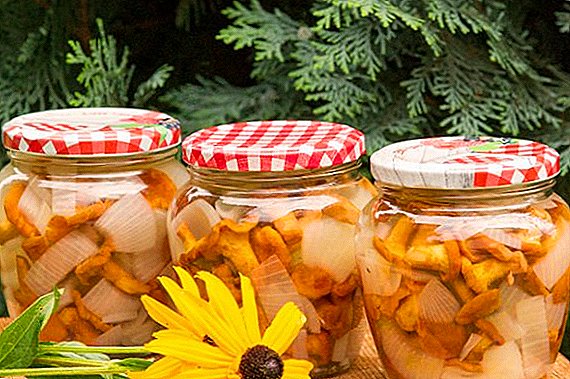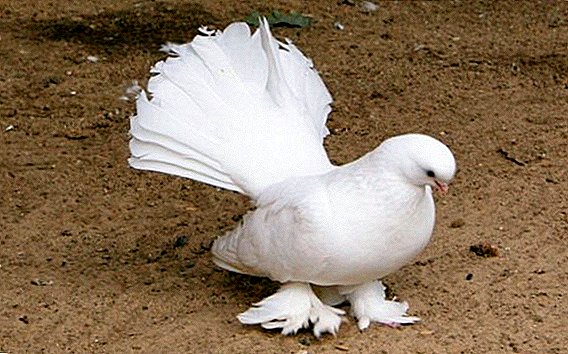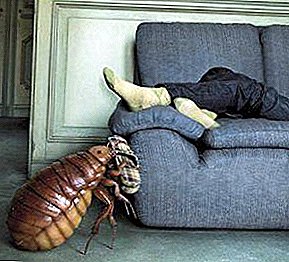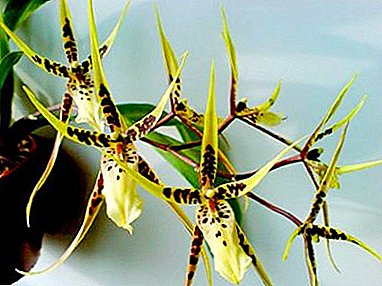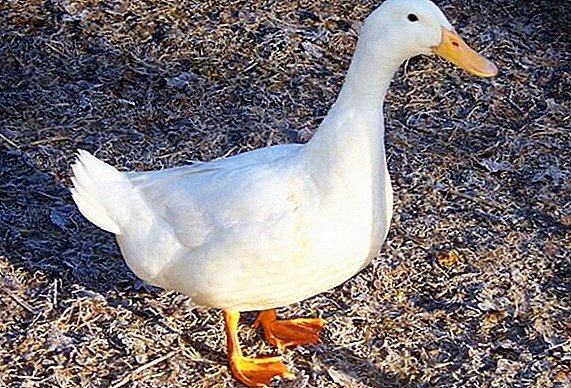 When deciding to breed domestic ducks, first of all it is necessary to determine the breed, because depending on the region, not every species can feel good. Cross Temp is a wonderful snow-white representative of the duck family, who feels great on the territory of Ukraine, Russia and Belarus. These ducks have not only an unusual exterior, but also have excellent valuable meat and are able to carry a large number of eggs.
When deciding to breed domestic ducks, first of all it is necessary to determine the breed, because depending on the region, not every species can feel good. Cross Temp is a wonderful snow-white representative of the duck family, who feels great on the territory of Ukraine, Russia and Belarus. These ducks have not only an unusual exterior, but also have excellent valuable meat and are able to carry a large number of eggs.
Origin and distribution
The distant relatives of the white ducks of the Cross Temp breed were the cold-resistant Cherry Valley, bred for living in the Russian climate from the English breed X-11.  Cherry Valley had quite good productive indicators, however, Belarusian breeders decided to cross them with Peking duck, which is an exclusively meat breed. As a result, ducklings (called Temp) appeared, whose feature was precociousness and abundant egg production.
Cherry Valley had quite good productive indicators, however, Belarusian breeders decided to cross them with Peking duck, which is an exclusively meat breed. As a result, ducklings (called Temp) appeared, whose feature was precociousness and abundant egg production.
You can also add that the minimum percentage of hatching chicks is 70%, which is an excellent indicator.
Did you know? Duck "quack" does not have an echo.
At the moment, this snow-white breed can very often be found at private farmers, as well as at professional breeders of poultry in Ukraine, Russia and Belarus. 
Breed description
Experienced farmers immediately distinguish the cross "Temp" on their external data, which distinguish them from any other domestic duck:
- Head. Small, proportional to the body.
- Beak. Yellow, large, not very narrowed to the end.
- Eyes. Two dark (black) points.
- Neck. Pronounced, long, has a slight bend.
- Wings. Large, have a wide scope with dense plumage.
- Feathers. The snow-white color, tight to each other.
- Torso. Large, has the shape of an oval.
- Tail. Small, slightly raised upwards, does not have long tail feathers.
- Paws. Proportional, large, yellow.
Check out the popular duck breeds. And also learn about the peculiarities of the maintenance of such breeds of ducks as the mulard, the Bashkir, the Peking, the blue favorite, the Gogol, the bogwarts.
All representatives of the cross-country are relatively unpretentious and very easy to maintain.
Productivity characteristic
Since the bird is considered precocious, it is already gaining weight by the age of two months.  Females usually weigh about 2.5 kg, drakes can weigh more than 3 kg. The breeders of this bird claim that during active growth (the first 2-2.5 months of life) the birds grow literally "before our eyes", and during the night they become noticeably larger.
Females usually weigh about 2.5 kg, drakes can weigh more than 3 kg. The breeders of this bird claim that during active growth (the first 2-2.5 months of life) the birds grow literally "before our eyes", and during the night they become noticeably larger.
The meat of these birds is characterized by low fat content (less than 20%), as well as the absence of a specific smell. Ducks are famous for their high egg production rates. During the reproductive period, one female can lay from 150 large eggs, which are 85-90% fertilized.
Growing at home
These representatives of poultry are considered one of the most beneficial, because they do not require special care, rarely get sick (with the right content) and have excellent productive indicators.
Did you know? Ducks torossa Pace feel great even in the absence of a reservoir.
Content
Despite the simplicity of this bird, certain rules should be strictly followed.  The duck family should live in a covered house and have a walking yard, as chicks and adults need to knead their legs and wings daily.
The duck family should live in a covered house and have a walking yard, as chicks and adults need to knead their legs and wings daily.
Necessary conditions in Utyatnik
The Utyatnik should be fairly light (at night, additional lighting is not required, as it causes stress), dry and spacious: each individual should be able to move freely around the "house".
It will also be useful for you to learn how to properly trim duck wings, how to properly and quickly pluck a duck at home, than useful duck eggs and duck fat.
An important point is good ventilation of the room: it is an excellent prevention of many diseases.
Representatives of this cross-country are frost-resistant ducks, therefore the temperature of + 18 ... + 20 ° С is quite optimal for them, with a humidity of 60-70%. 
Utyatnik care
On a clean (preferably disinfected) floor, it is imperative to lay the flooring out of straw, shavings or peat (height - not less than 15 cm). Some breeders sprinkle a layer of lime before flooring to get rid of excess moisture, but this is not necessary.
Laying ducks are required. They should be in a secluded place (away from the passage). You can make them from a mound of straw or fluff, and if you want to build your own hands from plywood, for which the bird will be very grateful.
Did you know? Duck "flippers" do not have nerve endings, so the bird does not freeze on ice.
Every few days it is imperative to partially change the litter, and once a week to remove the entire flooring and lay a new one. Once every two weeks it is desirable to carry out general cleaning with disinfection. 
Features of the content of chicks
Cross ducklings as well as adult birds are considered relatively unpretentious.
Learn how to raise ducklings in an incubator, how to feed ducklings in the first two weeks.
However, in order to achieve a 70% retention rate for chickens, a few simple rules must be followed:
- The diet of babies is somewhat different from parental food.
- In the first couple of weeks it is advisable to raise the temperature in the duckling to + 28 ... + 30 ° С. After this period, the chicks will get stronger and will be able to live in lower temperature conditions.
- In the presence of duck babies, additional lighting should be installed. For optimal growth of daylight hours, the first week should be 22 hours, the second - 14. In the third week of life, strong ducklings can go into the "adult mode".
- Young animals are more susceptible to all sorts of diseases, the number of cleanings is recommended to increase.

Walk and day regimen
Of course, one bird will not be enough for birds. The family must spend the daytime on the street. To do this, you need to build a walking yard, at the rate of 3 square meters per bird. Over the courtyard there must be a shed to avoid sunstroke.
Ideally, a small door is made from the house to the courtyard, which is open throughout the day, and in the evening ducks are driven into the house and the door is closed at night. Inside the poultry yard you can make several “floors” so that the bird can warm up during the day.
The fence for the walking place will be a high fence or mesh.
Breeding
Ducks have a slightly different breeding process from other domestic ducks. To get good offspring, the best ducks and drakes are selected at the rate of 7: 1 (females: males).  Sexual maturity in ducks occurs approximately on the 6th month of life and is divided into two periods of activity: spring and autumn. At this time, the male shows interest in females, after which they rush into the nests assigned to them (if there is not enough flooring in the nest, the duck will add its feathers to it).
Sexual maturity in ducks occurs approximately on the 6th month of life and is divided into two periods of activity: spring and autumn. At this time, the male shows interest in females, after which they rush into the nests assigned to them (if there is not enough flooring in the nest, the duck will add its feathers to it).
Important! It is recommended to establish tribal families in the fall and settle them separately, it is also advisable to build a small artificial reservoir in their pen.In order to give a hint to the duck where it needs to be carried, it is possible to lay plaster eggs in the nest, which correspond in size to duck.
After 28 days of heavy waiting and diligent hatching, the first “beaks” begin to appear. By 35-40 days, usually the whole family is already hatched and ready for rapid growth.
A special feature of the ducks is that if they wish to lay other people's eggs (such as chicken), she will refuse to engage them and most likely just throw them out of the nest. Ducks of this species can be bred by incubation. 
Feeding regime and optimal diet
As mentioned above, the diet of adult birds differs from feeding ducklings. This question is very important, so it is worth considering both types of food separately.
So, in order for the bird to receive all the necessary vitamins and trace elements, it must receive daily:
- proteins (bone meal, fish, meat, dairy products);
- animal fats;
- carbohydrates (wheat, burak, potatoes, oats);
- minerals and trace elements.
The ideal ration will be the purchase of mixed feed with the addition of vitamins and essential trace elements.
Feeding the ducklings will take a bit more trouble, because the growing body requires a lot of nutrients. 
The diet of babies should include:
- grain and flour feed;
- roots;
- greenery;
- proteins, fats and carbohydrates in larger quantities;
- more vitamins, because kids are at greater risk of contracting various diseases.
Important! It is also important to remember about clean water, which should be changed daily. In the case of ducks, this is especially important, because these birds clean the nasal canals with water from various impurities.
Pace refers to duck breeds that are not prone to obesity. Therefore, the bird should be fed to the dump, and the food in the feeder should be in constant access. 
Disease prevention
Ducks of this breed rarely suffer from serious diseases, provided that they are properly kept and that several necessary conditions are met:
- in addition to ventilation, it is necessary to additionally ventilate the room every week;
- to adhere to sanitary standards and to clean the utyatnik in time;
- make sure bedding and perches are dry;
- once every 2 weeks it is advisable to drink water with the addition of vitamin A, D and E 6 drops per liter of water (this will greatly enhance the immune system);
- in no case it is impossible to limit the bird in the range for a long time.
Dilution of Tempo cross is not only pleasant, but also extremely profitable. With little effort and effort, the farmer will get excellent, and most importantly - lean meat, without a specific smell.
Resistance to diseases is considered to be a separate advantage of this breed, because these birds rarely get sick with proper care. And for breeding a beautiful breed, you just need to create a duck tribe and "hint" the bird, where to incubate.


